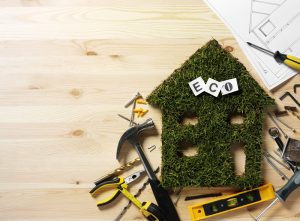
If you can afford not to, why go green in the first place? Even though an eco-friendly home is supposed to be good for the environment, how does it directly benefit you, the homeowner?
For one thing, a green home is good for your health. Paint, for example, contains chemicals with volatile organic compounds that can pose health risks. Formaldehyde in the glue used for composite wood products like laminate flooring can trigger asthma attacks and irritate the eyes, nose, and throat. Fortunately, there are now substitutes that skirt these problems.
Second, green upgrades increase the value of your home. A recent study showed that buyers pay an average of 3.46% more for energy – conserving homes. Some properties fetched premiums of as much as 7.7%.
Third, an eco-friendly home requires less maintenance in the long run. For example, a lawn using native grass often thrives without fertilizers and requires up to 70% less water to maintain. That saves up to 60 hours of your time in maintenance work and, in drier locations, has a dollar equivalent of up to $3,500.
So, what do you need to do to reap these benefits?
-
Learn the language
-
Undergo an energy audit
-
Use smart home technologies
-
Major upgrades that pay
- The “passive house” design
- Double-pane windows
- Solar solutions
If you’re unfamiliar with terms like “gray water” or “pervious concrete,” it’s time to get up to speed on the lingo and technologies used to turn your home green. For your reference, Realtor.com has a useful glossary of terms that can help you keep as you plan and carry out your home improvements.
A certified energy auditor will thoroughly scan your home, determining how heat moves throughout the home and detecting any leaks and other inefficiencies. This will give you a clear idea of the specific upgrades and renovations your house needs. An audit allows you to focus upgrades only on things that add significant benefit to your home improvement efforts.
To find an auditor near your area, you can search the Residential Energy Services Network directory. Audits typically cost from between $300 to $500 with rebates off setting this expense in the long term.
Programmable thermostats allow you regulate the temperature of your home at particular times of the day. You can have them turn off ACs when no one’s home or lower temps when occupants are asleep.
Wi-Fi-connected switches lets you turn appliances – coffeemakers, humidifiers, and even curling irons – on and off remotely. Similarly, you can control kitchen appliances, security cameras, and home entertainment using many other phone apps.
Even more basic solutions like sensor – based lights can help you significantly cut down on energy costs by eliminating the all-too-common tendency to leave lights on in rooms that are not in use.
For major renovations, consider the following:
A passive house is one that is sealed air-tight, ensuring that temperature-controlled air doesn’t leak out. This deliberate design minimizes cooling and heating needs and consequently your energy consumption.
In line with the passive home design, double-
and triple-pane windows feature a layer of insulating Freon gas in between panes that helps improve indoor cooling. Reflective coating is also a practical investment that can pay huge dividends during the hot summer months.
In the Greater Houston area, the humid subtropical climate can accommodate a solar panel array. Want to be sure that your home is in the right place to maximize solar power? Check your address on Google’s Project Sunroof, which tells you how much usable sunlight your location gets and can even give you an estimate of your potential energy cost savings for the next 20 years.




